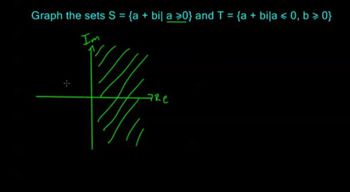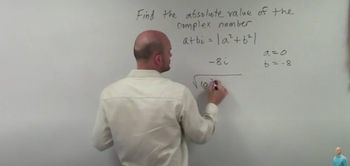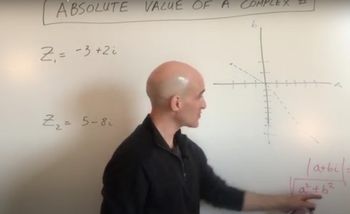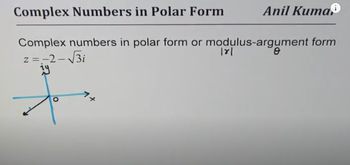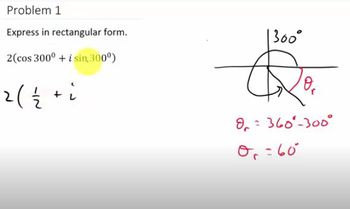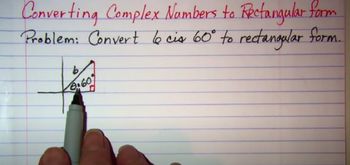Table of contents
- 0. Review of College Algebra4h 43m
- 1. Measuring Angles39m
- 2. Trigonometric Functions on Right Triangles2h 5m
- 3. Unit Circle1h 19m
- 4. Graphing Trigonometric Functions1h 19m
- 5. Inverse Trigonometric Functions and Basic Trigonometric Equations1h 41m
- 6. Trigonometric Identities and More Equations2h 34m
- 7. Non-Right Triangles1h 38m
- 8. Vectors2h 25m
- 9. Polar Equations2h 5m
- 10. Parametric Equations1h 6m
- 11. Graphing Complex Numbers1h 7m
11. Graphing Complex Numbers
Polar Form of Complex Numbers
Problem 5
Textbook Question
In Exercises 1–10, plot each complex number and find its absolute value. z = 3 + 2i
 Verified step by step guidance
Verified step by step guidance1
Step 1: Identify the real and imaginary parts of the complex number. For the complex number \( z = 3 + 2i \), the real part is 3 and the imaginary part is 2.
Step 2: Plot the complex number on the complex plane. The horizontal axis represents the real part, and the vertical axis represents the imaginary part. Plot the point (3, 2) on this plane.
Step 3: To find the absolute value of the complex number \( z = 3 + 2i \), use the formula \( |z| = \sqrt{a^2 + b^2} \), where \( a \) is the real part and \( b \) is the imaginary part.
Step 4: Substitute the values of \( a \) and \( b \) into the formula. Here, \( a = 3 \) and \( b = 2 \), so the expression becomes \( |z| = \sqrt{3^2 + 2^2} \).
Step 5: Simplify the expression under the square root to find the absolute value. Calculate \( 3^2 \) and \( 2^2 \), then add the results and take the square root.
Recommended similar problem, with video answer:
 Verified Solution
Verified SolutionThis video solution was recommended by our tutors as helpful for the problem above
Video duration:
1mPlay a video:
Was this helpful?
Key Concepts
Here are the essential concepts you must grasp in order to answer the question correctly.
Complex Numbers
Complex numbers are numbers that have a real part and an imaginary part, expressed in the form z = a + bi, where 'a' is the real part, 'b' is the coefficient of the imaginary unit 'i', and 'i' is defined as the square root of -1. In the given example, z = 3 + 2i, 3 is the real part and 2 is the imaginary part.
Recommended video:

Dividing Complex Numbers
Plotting Complex Numbers
Complex numbers can be represented graphically on the complex plane, where the x-axis represents the real part and the y-axis represents the imaginary part. For the complex number z = 3 + 2i, it would be plotted at the point (3, 2) on this plane, allowing for a visual understanding of its position relative to the origin.
Recommended video:

How To Plot Complex Numbers
Absolute Value of Complex Numbers
The absolute value (or modulus) of a complex number z = a + bi is calculated using the formula |z| = √(a² + b²). This value represents the distance of the point (a, b) from the origin in the complex plane. For z = 3 + 2i, the absolute value would be |z| = √(3² + 2²) = √(9 + 4) = √13.
Recommended video:

Dividing Complex Numbers

 4:47m
4:47mWatch next
Master Complex Numbers In Polar Form with a bite sized video explanation from Nick Kaneko
Start learningRelated Videos
Related Practice





